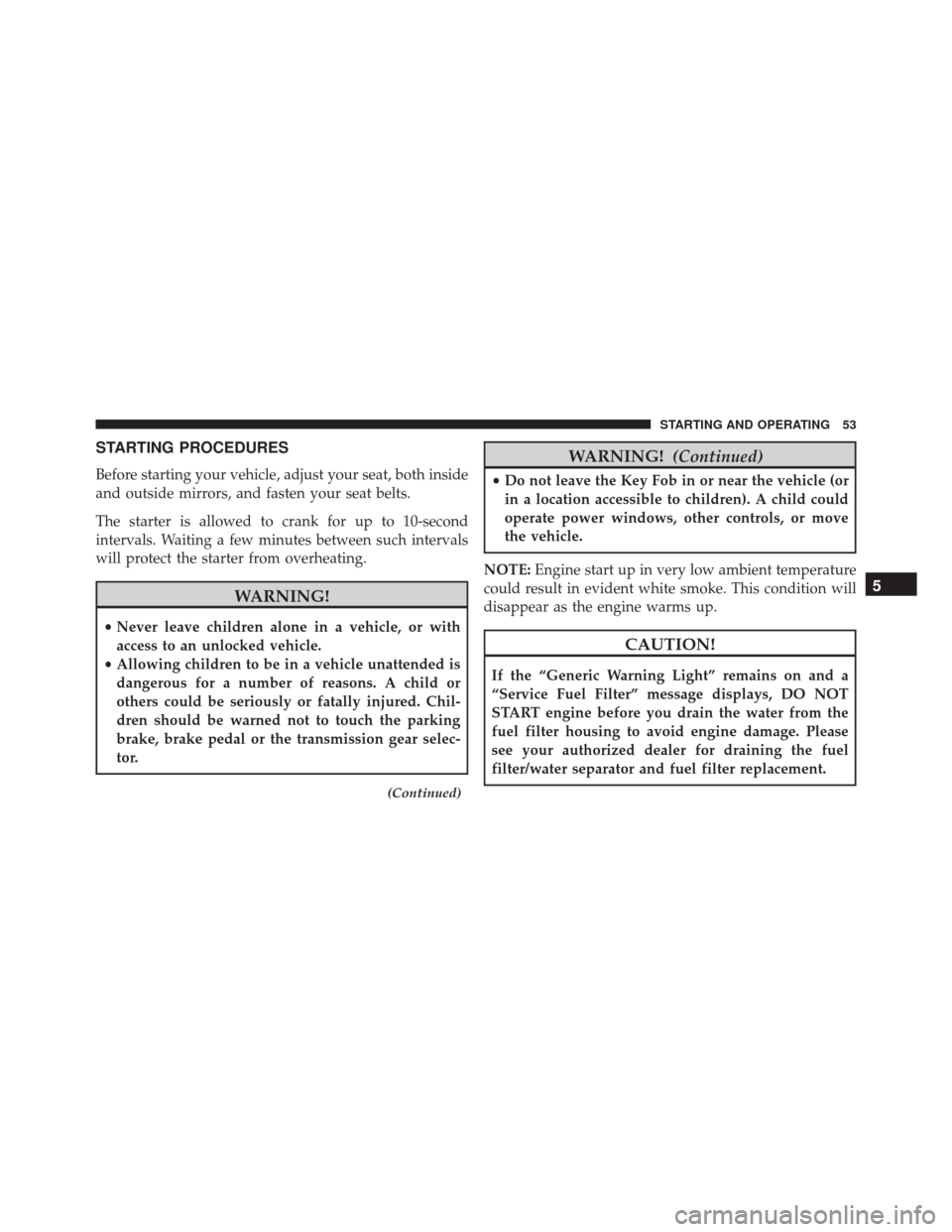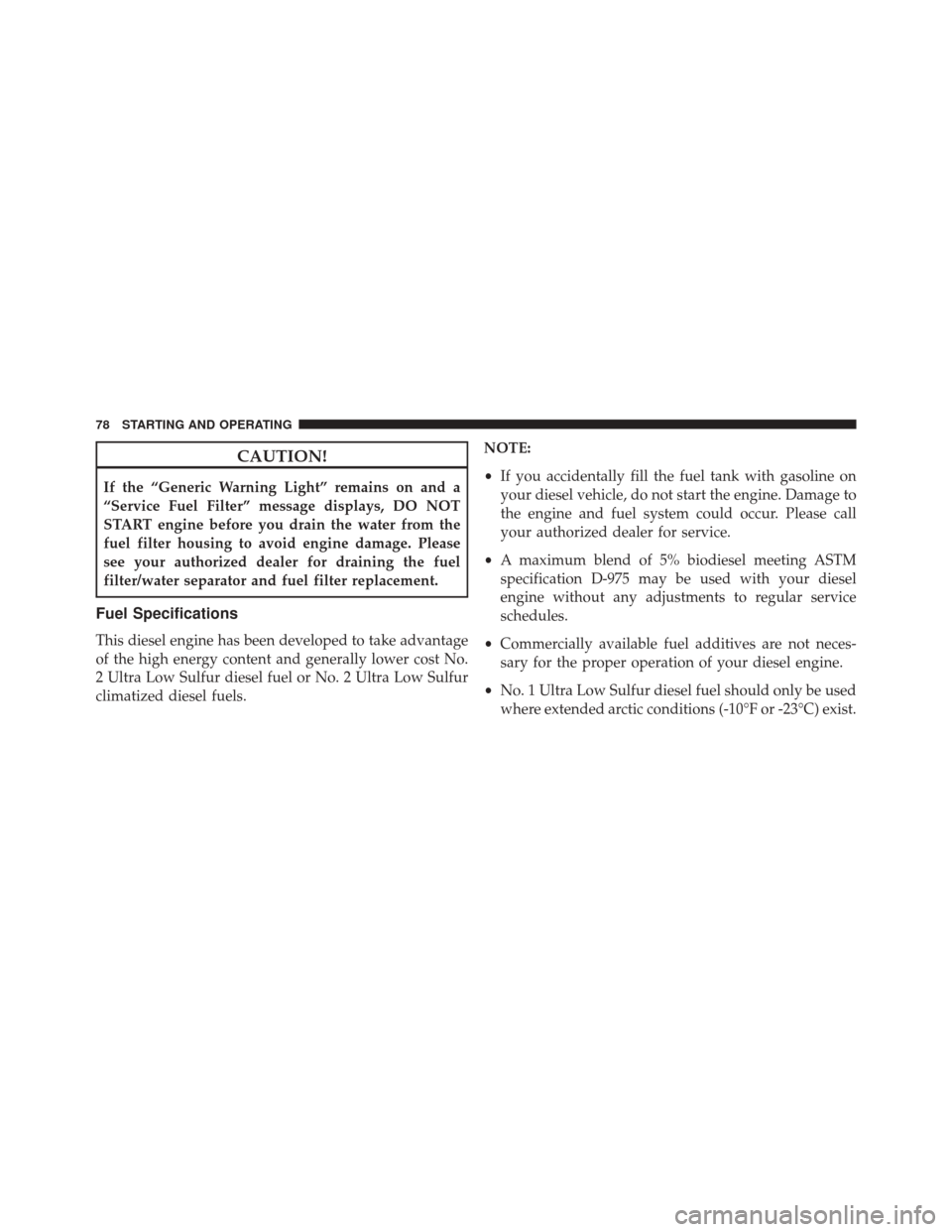2016 Ram ProMaster fuel filter
[x] Cancel search: fuel filterPage 55 of 145

STARTING PROCEDURES
Before starting your vehicle, adjust your seat, both inside
and outside mirrors, and fasten your seat belts.
The starter is allowed to crank for up to 10-second
intervals. Waiting a few minutes between such intervals
will protect the starter from overheating.
WARNING!
•Never leave children alone in a vehicle, or with
access to an unlocked vehicle.
• Allowing children to be in a vehicle unattended is
dangerous for a number of reasons. A child or
others could be seriously or fatally injured. Chil-
dren should be warned not to touch the parking
brake, brake pedal or the transmission gear selec-
tor.
(Continued)
WARNING! (Continued)
•Do not leave the Key Fob in or near the vehicle (or
in a location accessible to children). A child could
operate power windows, other controls, or move
the vehicle.
NOTE: Engine start up in very low ambient temperature
could result in evident white smoke. This condition will
disappear as the engine warms up.
CAUTION!
If the “Generic Warning Light” remains on and a
“Service Fuel Filter” message displays, DO NOT
START engine before you drain the water from the
fuel filter housing to avoid engine damage. Please
see your authorized dealer for draining the fuel
filter/water separator and fuel filter replacement.
5
STARTING AND OPERATING 53
Page 56 of 145

Normal Starting Procedure
The shift lever must be in the NEUTRAL (N) position,
and the brake pedal must be pressed, to allow engine
cranking. Place the shift lever in NEUTRAL (N) and
apply the brake pedal BEFORE turning the key to the
START/AVV position; otherwise, the engine will not
crank and the key must be cycled OFF, then back on,
before cranking is allowed.
Observe the instrument panel cluster lights when starting
the engine.
NOTE:Normal starting of either a cold or a warm
engine is obtained without pumping or pressing the
accelerator pedal.
1. Press and hold the brake pedal.
2. Place the shift lever into the NEUTRAL (N) position while keeping the brake pedal depressed. 3. Turn the ignition switch to the ON/RUN/MAR posi-
tion and watch the instrument panel cluster lights.
CAUTION!
If the “Generic Warning Light” remains on and a
“Service Fuel Filter” message displays, DO NOT
START engine before you drain the water from the
fuel filter housing to avoid engine damage. Please
see your authorized dealer for draining the fuel
filter/water separator and fuel filter replacement.
4. After the Glow Plug light turns off, turn the ignition switch to the AVV (START) position to start the engine.
Do not press the accelerator during starting.
5. If you wish to stop the cranking of the engine prior to the engine starting, release the ignition key so that it
turns back to the ON/RUN position.
54 STARTING AND OPERATING
Page 59 of 145

NOTE:The engine and transmission block heater cord is
a factory installed option. If your vehicle is not equipped,
heater cords are available from your authorized MOPAR
dealer.
• A 12 Volt heater built into the fuel filter housing aids in
preventing fuel gelling. It is controlled by a built-in
thermostat.
• A Diesel Pre-Heat system both improves engine start-
ing and reduces the amount of white smoke generated
by a warming engine.
NORMAL OPERATION
Observe the following when the diesel engine is operating.
• All message center lights are off.
• Malfunction Indicator Light (MIL) is off.
• Generic Warning Light is off.
• Engine Oil Pressure telltale is not illuminated.
Cold Weather Precautions
Operation in ambient temperature below 32°F (0°C) may
require special considerations. The following charts sug-
gest these options:
Fuel Operating Range
NOTE: Use “Ultra Low Sulfur Diesel Fuels” ONLY.
*No. 1 Ultra Low Sulfur Diesel Fuel should only be used
where extended arctic conditions (-10°F/-23°C) exist.
Fuel Operating Range Chart
5
STARTING AND OPERATING 57
Page 79 of 145

For most year-round service, No. 2 diesel fuel meeting
ASTM (formerly known as the American Society for
Testing and Materials) specification D-975 Grade S15 will
provide good performance.
If the vehicle is exposed to extreme cold (below 20°F or
-7°C), or is required to operate at colder-than-normal
conditions for prolonged periods, use climatized No. 2
diesel fuel or dilute the No. 2 diesel fuel with 50% No. 1
diesel fuel. This will provide better protection from fuel
gelling or wax-plugging of the fuel filter.
WARNING!
Do not use alcohol or gasoline as a fuel blending
agent. They can be unstable under certain conditions
and hazardous or explosive when mixed with diesel
fuel.Diesel fuel is seldom completely free of water. If water is
detected in the water separator while the engine is
running or while the ignition switch is in the ON/RUN
position, the “Generic Warning Light” will illuminate
and the specific message, “Service Fuel Filter” will ap-
pear in the Electronic Vehicle Information Center (EVIC).
If this occurs you should stop the engine and drain the
water from the filter housing.
NOTE:
Please see your authorized dealer for draining the
fuel/water separator and fuel filter replacement.
Purchasing good quality fuel and by following the cold
weather advice above, fuel conditioners should not be
required in your vehicle.
NOTE: If available in your area, a high cetane “pre-
mium” diesel fuel may offer improved cold-starting and
warm-up performance.
5
STARTING AND OPERATING 77
Page 80 of 145

CAUTION!
If the “Generic Warning Light” remains on and a
“Service Fuel Filter” message displays, DO NOT
START engine before you drain the water from the
fuel filter housing to avoid engine damage. Please
see your authorized dealer for draining the fuel
filter/water separator and fuel filter replacement.
Fuel Specifications
This diesel engine has been developed to take advantage
of the high energy content and generally lower cost No.
2 Ultra Low Sulfur diesel fuel or No. 2 Ultra Low Sulfur
climatized diesel fuels.NOTE:
•
If you accidentally fill the fuel tank with gasoline on
your diesel vehicle, do not start the engine. Damage to
the engine and fuel system could occur. Please call
your authorized dealer for service.
• A maximum blend of 5% biodiesel meeting ASTM
specification D-975 may be used with your diesel
engine without any adjustments to regular service
schedules.
• Commercially available fuel additives are not neces-
sary for the proper operation of your diesel engine.
• No. 1 Ultra Low Sulfur diesel fuel should only be used
where extended arctic conditions (-10°F or -23°C) exist.
78 STARTING AND OPERATING
Page 81 of 145

Biodiesel Fuel Requirements
A maximum blend of 5% biodiesel meeting ASTM speci-
fication D975 is recommended for use with your diesel
engine. If frequent operation with Biodiesel blends that
are between 6% and 20% (B6–B20) is desired, the main-
tenance schedule is subject to shorter intervals.
The oil and filter change along with fuel filter replace-
ment is subject to shorter intervals when operating your
engine on biodiesel greater than 5%. Do not use biodiesel
greater than 20%.
For regular use of biodiesel blends between 6% and 20%
(B6–B20) it is important that you understand and comply
with these requirements. Refer to the “Maintenance
Chart” in the “Maintenance Schedules” section for fur-
ther direction.
CAUTION!
Failure to comply with Oil Change requirements for
vehicles operating on biodiesel blends between 6%
and 20% (B6–B20) will result in premature engine
wear. Such wear is not covered by the New Vehicle
Limited Warranty.
Biodiesel is a fuel produced from renewable resources
typically derived from animal fat, rapeseed oil (Rapeseed
Methyl Ester (RME) base), or soybean oil (Soy Methyl
Ester (SME or SOME) base).
Biodiesel fuel has inherent limitations which require that
you understand and adhere to the following requirements
if you use blends of Biodiesel between 6% and 20%
(B6–B20). There are no unique restrictions for the use of B5.
5
STARTING AND OPERATING 79
Page 83 of 145

Fuel Water Separation — Must Use Mopar
Approved Fuel Filter Elements
Biodiesel fuel has a natural affinity to water and water
accelerates microbial growth. Your Mopar filtration sys-
tem is designed to provide adequate fuel water separa-
tion capabilities.
Fuel In Oil Dilution — Must Adhere To Required
Oil Change
Fuel dilution of lubricating oil has been observed with
the use of biodiesel fuel. Fuel in oil must not exceed 5%.
To ensure this limit is met your oil change interval must
be maintained with in the suggested schedule.
The regular use of biofuels greater than 5% and less than
20% require intervals shorter than the outlined 18,500 miles
(29 773 km) and must not exceed the suggested schedule.
When routinely operating on biofuels greater that 5% and
less than 20%, oil and filter replacement intervals must not
exceed 10,000 miles (16 093 km) or 6 months, which ever
comes first.
Biodiesel Fuel Filter Change Intervals
The use of biofuels require intervals shorter than the
outlined 30,000 miles (48 280 km) and must not exceed
the suggested schedule. When operating on biofuels
greater that 5% and less than 20%, fuel filter replacement
intervals must not exceed 20,000 Miles (40 233 km).
NOTE:
•Under no circumstances should oil change intervals
exceed 10,000 miles (16 093 km) or 6 months, if regular
operation occurs with greater than 5% and less than
20% biodiesel blends.
•
Under no circumstances should fuel filter intervals
exceed 20,000 miles (40 233 km), if regular operation
occurs with greater than 5% and less than 20% biodiesel
blends.
5
STARTING AND OPERATING 81
Page 84 of 145

CAUTION!
Failure to comply with these Oil Change and fuel
filter requirements for vehicles operating on bio-
diesel blends up to B20 may result in premature
engine wear. Such wear is not covered by the New
Vehicle Limited Warranty. The engine may suffer
severe damage if operated with concentrations of
biodiesel higher than 20%.
ADDING FUEL
The fuel cap is located behind the fuel filler door on the
left side of the vehicle. If the fuel cap is lost or damaged,
be sure the replacement cap is for use with this vehicle.
CAUTION!
To avoid fuel spillage and overfilling, do not “top
off” the fuel tank after filling.
1 — Diesel Fuel Fill Location
2 — Diesel Exhaust Fluid (DEF) Fill Location
82 STARTING AND OPERATING